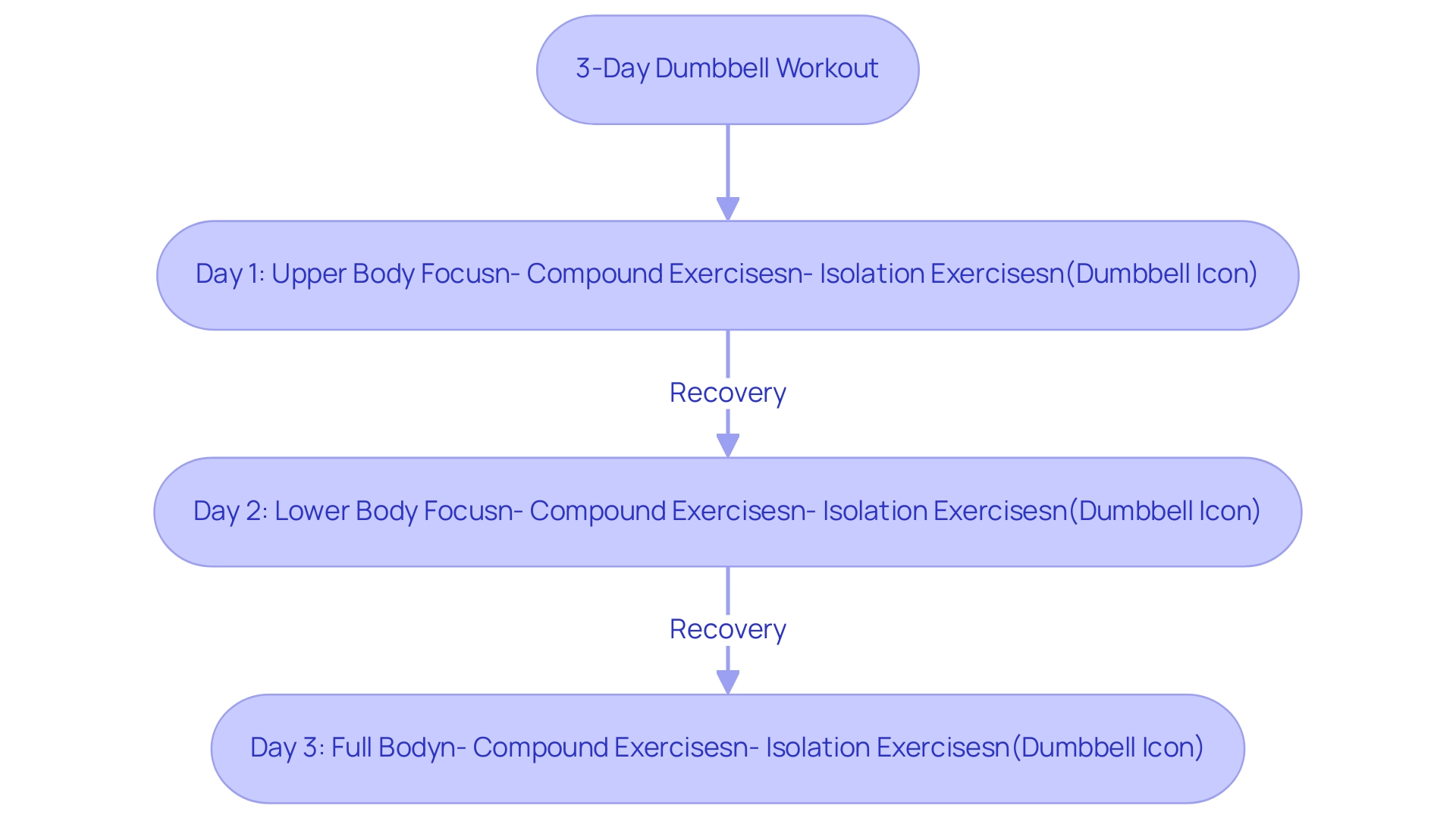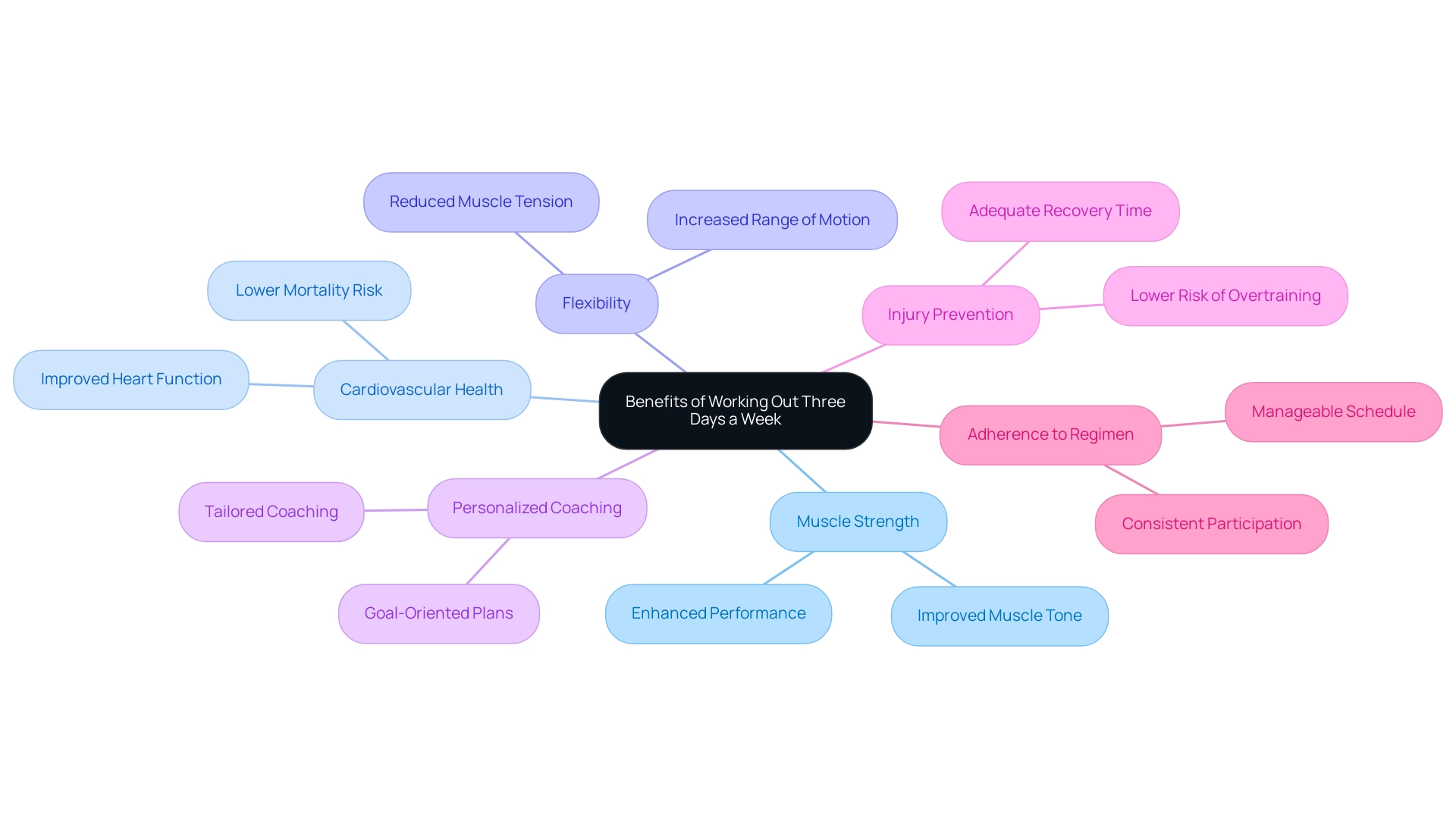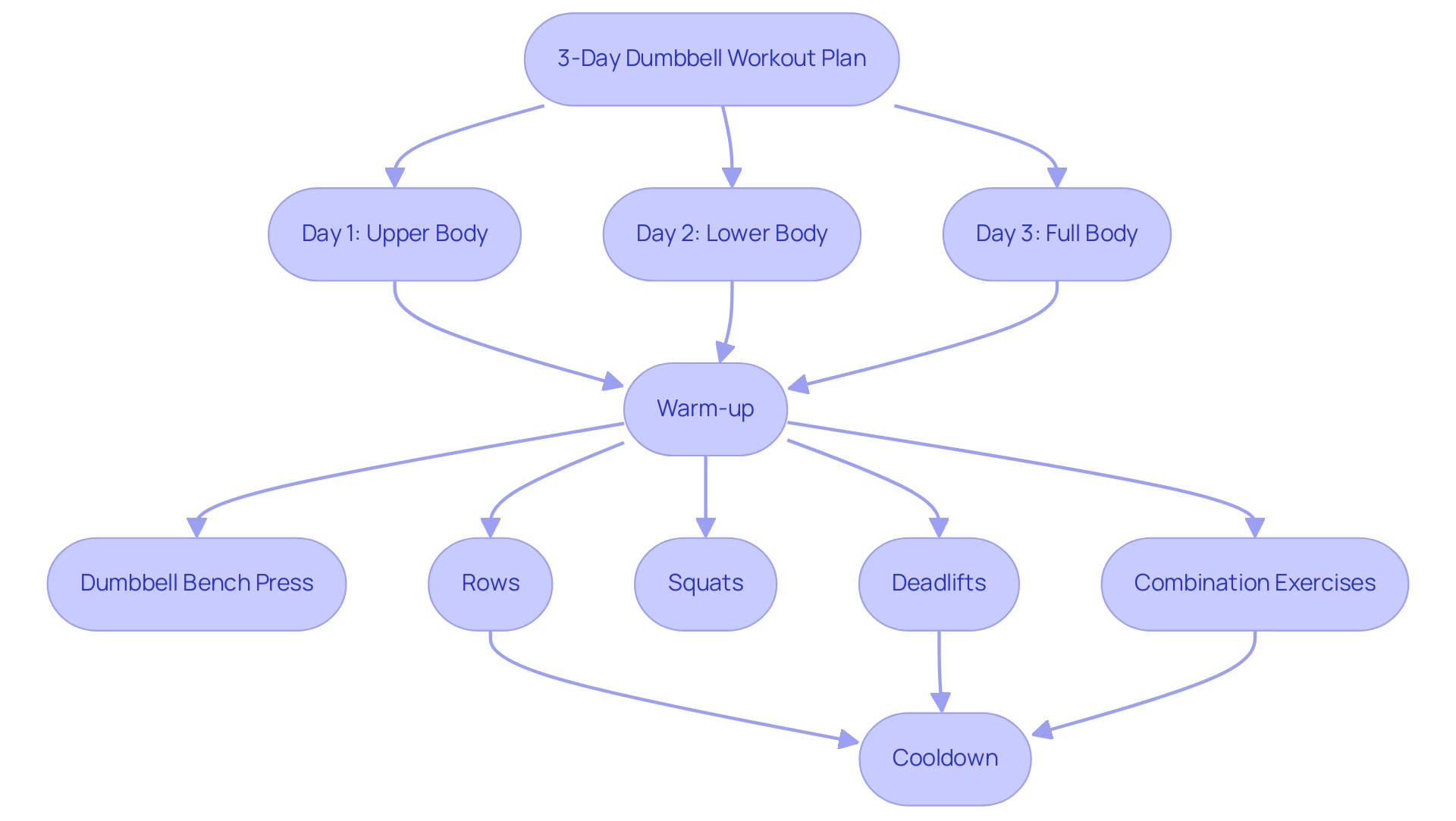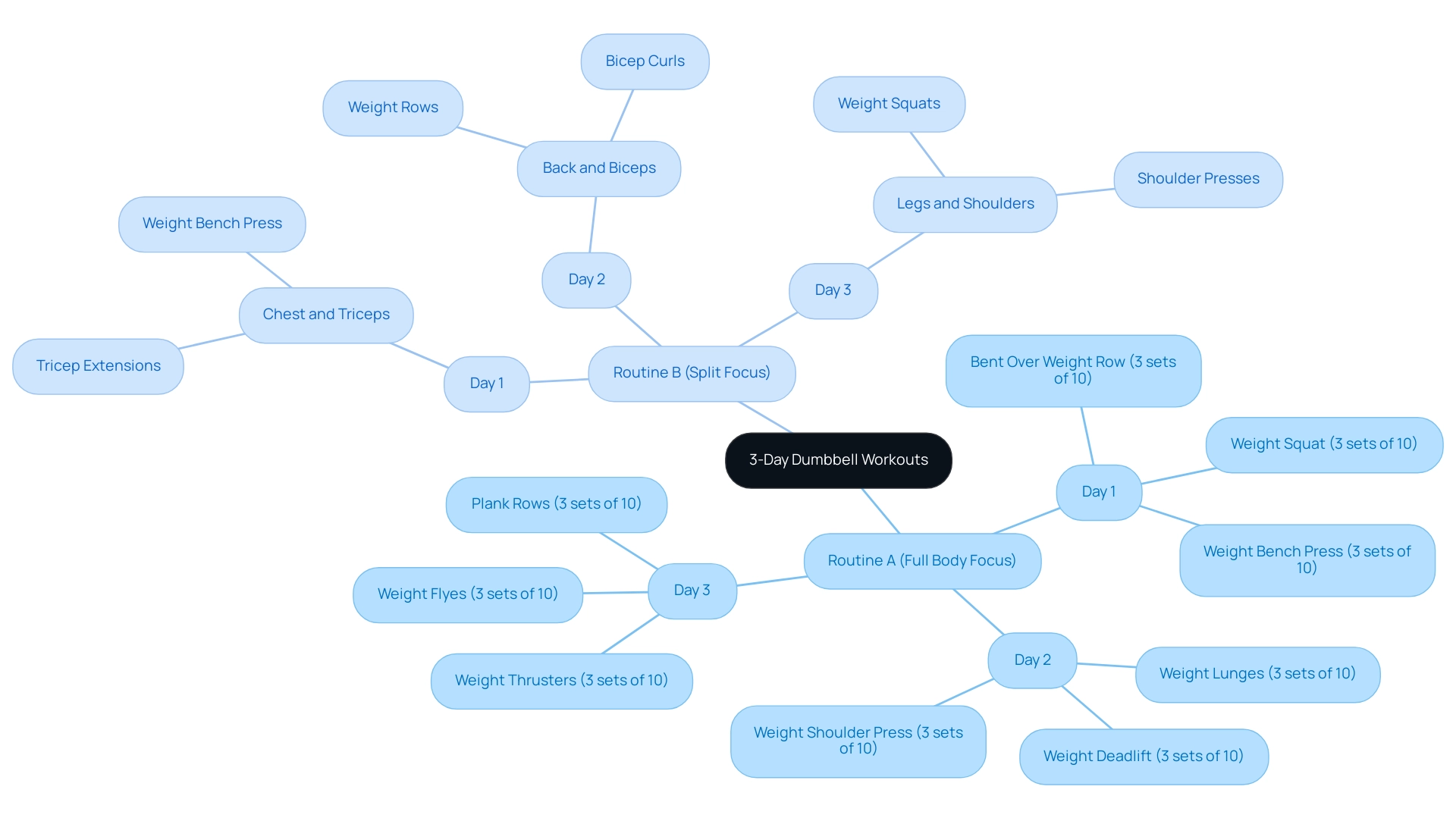Overview
A 3-day per week dumbbell workout represents a meticulously organized training plan that integrates various muscle group exercises, promoting balanced intensity and recovery. This approach is particularly advantageous for beginners and individuals with demanding schedules. The article elaborates on the structured nature of these workouts, highlighting benefits such as enhanced strength and improved cardiovascular health. Furthermore, it presents compelling evidence from studies that demonstrate significant gains in muscle performance, thereby reinforcing the workout's effectiveness as a strategic fitness solution.
Introduction
In the realm of fitness, the 3-day dumbbell workout stands out as a formidable solution for individuals pursuing a balanced approach to strength training. This regimen is crafted to be both effective and manageable, enabling participants to engage multiple muscle groups while ensuring adequate recovery time. Given that busy lifestyles often impede consistent gym attendance, this structured plan is designed for both novices and seasoned athletes, offering a diverse array of exercises that can be tailored to personal goals.
Backed by scientific evidence underscoring its effectiveness, the 3-day split not only promises substantial strength gains but also emphasizes the necessity of proper technique and personalized coaching. As the fitness landscape evolves, this method is gaining traction, inviting many to explore the transformative benefits of a comprehensive workout routine.
Defining the 3-Day Per Week Dumbbell Workout
The three-day-per-week dumbbell workout represents an effective and organized training plan, meticulously designed for execution three times a week. This structure emphasizes engaging various muscle groups or providing full-body exercises, enabling individuals to effectively balance exercise intensity with essential recovery periods. Such an approach is particularly advantageous for beginners and those managing busy schedules.
Each session typically incorporates a combination of compound and isolation exercises, utilizing dumbbells as the primary equipment. This versatility not only accommodates varied activity levels but also facilitates the creation of customized routines aligned with personal wellness goals. A study involving nineteen participants underscored the effectiveness of this method, demonstrating significant strength gains.
For instance, the case study conducted by Arazi and Asadi revealed that participants experienced a 10.6% increase in multi-joint exercises and a 14.8% increase in isolation exercises over a week-long training program. Helene Pedersen reinforces the credibility of such findings, stating, 'This study was conducted without any funding from companies, manufacturers, or outside organizations.' Recent trends indicate that this method is gaining traction in 2024, as individuals increasingly acknowledge the importance of a well-rounded strength training program.

Benefits of Working Out Three Days a Week
Engaging in a personalized 3-day-per-week dumbbell workout presents numerous advantages for physical health and personal well-being. This structured approach not only enhances muscle strength, improves cardiovascular health, and increases flexibility, but also ensures that individuals receive tailored guidance from experienced coaches. As one client shared, 'The personalized coaching I received transformed my approach to health, making it both enjoyable and effective.'
Such a manageable schedule encourages adherence to a consistent exercise regimen without overwhelming participants. The recovery intervals between training sessions are essential for muscle repair and growth, significantly lowering the risk of injury. Recent research underscores that individuals committed to a 3-day-per-week dumbbell workout can achieve noteworthy improvements in their health.
Specifically, studies indicate that this frequency fosters muscle strength improvements while providing adequate recovery time—making it an ideal strategy for both novices and seasoned athletes. Moreover, the impact of physical activity on mortality risk remains consistent across different age groups, emphasizing the broader health benefits of regular exercise. As demonstrated in the case study titled 'High Intensity Exercise and Cardiovascular Health,' long-term vigorous physical activity, supported by evidence-based techniques, does not adversely affect cardiovascular health.
This collaborative effort in validating the benefits of a 3-day-per-week dumbbell workout reinforces the importance of personalized coaching tailored to individual needs. For instance, our coaches modify exercise plans based on fitness levels and goals, ensuring everyone can thrive. Let’s discuss how we can help you take control of your health and well-being—contact us today to schedule a consultation!

How to Structure Your 3-Day Dumbbell Workout Plan
An effective three-day-per-week dumbbell workout can be structured around exercise categories such as push, pull, and legs, or it can incorporate full-body sessions. For instance:
- Day 1 can be dedicated to upper body exercises, including dumbbell bench presses and rows.
- Day 2 targets the lower body with movements like squats and deadlifts.
- On Day 3, a full-body exercise can be introduced to engage multiple muscle groups, ensuring a well-rounded approach to strength training.
Each session should begin with a proper warm-up to prepare the body, followed by targeted exercises for various muscle groups, and conclude with a cooldown to aid recovery. It is crucial to schedule at least one rest day between exercises, as this allows the muscles to recover and helps prevent overtraining—a principle supported by research indicating that training frequency alone does not guarantee greater strength gains when volume is consistent.
The study titled "Implications for Training Frequency" suggests that both Split and Full-Body Workout Routines can be effectively utilized without significant differences in strength and hypertrophy outcomes, providing trainers with flexibility in designing individualized training programs.
Furthermore, managing the weekly volume of collections and making attempts to adjust external loads is essential for optimizing results. As Julia Maria D'Andrea Greve noted, understanding these dynamics can significantly impact training effectiveness. By adhering to these guidelines, trainers can create effective and personalized dumbbell exercise routines that meet individual goals.

Sample 3-Day Dumbbell Workout Routines
Here are two sample 3-day weight training routines designed to cater to different training focuses:
Routine A (Full Body Focus):
- Day 1: Weight Squat (3 sets of 10), Weight Bench Press (3 sets of 10), Bent Over Weight Row (3 sets of 10)
- Day 2: Weight Lunges (3 sets of 10), Weight Shoulder Press (3 sets of 10), Weight Deadlift (3 sets of 10)
- Day 3: Weight Thrusters (3 sets of 10), Weight Flyes (3 sets of 10), Plank Rows (3 sets of 10)
Routine B (Split Focus):
- Day 1: Chest and Triceps (Weight Bench Press and Tricep Extensions)
- Day 2: Back and Biceps (Weight Rows and Bicep Curls)
- Day 3: Legs and Shoulders (Weight Squats and Shoulder Presses)
These routines can be tailored according to individual fitness levels. For instance, if three sets of 10 reps feel manageable, participants are encouraged to increase the repetitions, add extra sets, or decrease rest periods to enhance the intensity of the exercise. Participants can go as high as 25 reps to further challenge themselves.
According to Josh, a certified personal trainer,
You can do more reps and perform them at a slower speed to make this more challenging until you get more dumbbells.
Monitoring performance is essential; for instance, on Day One of the exercise regimen, participants engage in a 30-minute circuit that includes activities such as the Dumbbell Floor Press and Bent-Over Row. This structure promotes high-quality rounds while encouraging participants to enhance their performance over time, exemplifying the significance of maintaining form and progressively increasing intensity.

Avoiding Pitfalls: Tips for a Successful 3-Day Workout
Achieving success with a 3-day dumbbell workout necessitates a focus on several key strategies:
-
Prioritize Proper Form: Correct form is essential for preventing injuries and maximizing workout efficacy. If you're uncertain about your technique, consulting a health expert can provide guidance and reassurance. As Louis Ha, an online wellness coach, emphasizes, "The road to success in health is paved with dedication, perseverance, and knowledge."
-
Listen to Your Body: Being attuned to your body's signals is crucial. If you experience fatigue or discomfort, it’s important to adjust your routine to allow for adequate recovery, which is fundamental in any training program. Research indicates that women reported considerably greater energy expenditure over a week than men, underscoring the necessity for customized strategies in exercise intensity and recovery.
-
Stay Consistent: Consistency in your 3-day per week dumbbell workout is vital for seeing tangible results. Aim to adhere closely to your exercise schedule, including a 3-day per week dumbbell workout, as regularity helps reinforce habits and contributes to overall fitness goals. The case study by Woolf-May et al. (1999) found no significant differences in adherence rates among participants, emphasizing that sticking to a routine is key to success.
-
Incorporate Variety: To keep your routines engaging and to challenge your muscles, change your exercises every few weeks. This approach not only combats boredom but also promotes continuous progress in strength.
-
Hydrate and Fuel: Proper hydration and a balanced diet are crucial for supporting your workouts and aiding recovery. Ensure that you're drinking sufficient water and nourishing your body with the right nutrients to optimize your performance.

Conclusion
The 3-day dumbbell workout presents a structured and effective approach to strength training, catering to individuals of varying fitness levels and busy lifestyles. By concentrating on major muscle groups and allowing for adequate recovery, this regimen promotes significant strength gains while minimizing the risk of injury. The integration of compound and isolation exercises ensures a well-rounded workout that can be tailored to personal goals, making it accessible for both novices and experienced athletes.
Incorporating personalized coaching into this routine significantly enhances the training experience, enabling participants to receive guidance that aligns with their individual needs. This tailored approach not only fosters adherence to the workout schedule but also encourages continuous improvement and engagement. Furthermore, the flexibility in structuring workouts—whether through push/pull/legs or full-body sessions—provides the versatility needed to keep routines fresh and effective.
Ultimately, the 3-day dumbbell workout stands out as a sustainable fitness solution that balances intensity with recovery. By emphasizing proper form, consistency, and variety, individuals can maximize their results and enjoy the numerous health benefits associated with regular exercise. As this method continues to gain popularity, it invites many to explore its transformative potential, paving the way for a healthier and more active lifestyle.
Frequently Asked Questions
What is the structure of the three-day-per-week dumbbell workout?
The three-day-per-week dumbbell workout is an organized training plan designed for execution three times a week, focusing on engaging various muscle groups or providing full-body exercises while balancing exercise intensity with recovery periods.
Who can benefit from this workout plan?
This workout plan is particularly advantageous for beginners and individuals managing busy schedules, as it allows for effective training without overwhelming participants.
What types of exercises are included in the sessions?
Each session typically includes a combination of compound and isolation exercises, primarily utilizing dumbbells as equipment.
How does this workout method accommodate different fitness levels?
The versatility of the dumbbell workout allows for the creation of customized routines that align with personal wellness goals, accommodating various activity levels.
What evidence supports the effectiveness of this training method?
A study involving nineteen participants showed significant strength gains, with a 10.6% increase in multi-joint exercises and a 14.8% increase in isolation exercises over a week-long training program.
What are the health benefits of engaging in a personalized 3-day-per-week dumbbell workout?
This structured approach enhances muscle strength, improves cardiovascular health, increases flexibility, and provides tailored guidance from experienced coaches.
How does the recovery interval impact the workout effectiveness?
The recovery intervals between training sessions are essential for muscle repair and growth, significantly lowering the risk of injury and allowing for noteworthy health improvements.
Is this workout suitable for both novices and seasoned athletes?
Yes, the 3-day-per-week dumbbell workout is ideal for both novices and seasoned athletes, as it fosters muscle strength improvements while providing adequate recovery time.
What broader health benefits are associated with regular exercise?
Regular exercise has consistent health benefits across different age groups, including improvements in muscle strength and a lower mortality risk.
How do personalized coaching services enhance the workout experience?
Coaches modify exercise plans based on individual fitness levels and goals, ensuring that everyone can thrive and achieve their health and wellness objectives.

